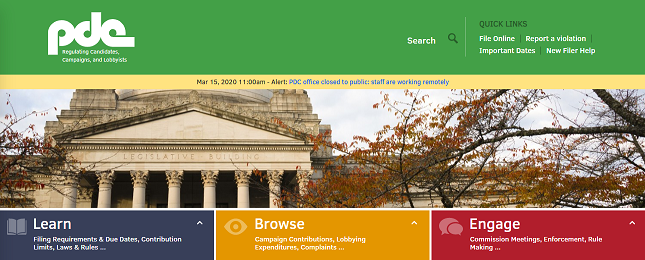
Cash, Campaigns, and Contributions
New dashboard shows the buck started here
by Trends Staff
Most everyone is familiar with the three branches of democracy: the legislative branch, the executive branch, and the judicial branch. The fourth “branch”, a free media, is not a part of government but no less important to democracy. So, when these government and non-government entities are considered together as key to a democratic system, they are the four pillars of democracy.
By the time America had won independence and had ratified the first edition of the Constitution, or the second edition with the first ten amendments creating the Bill of Rights occurred, the camera had yet to be invented. The camera obscura, better known as a box camera, was still a few decades away from invention.
Newspapers and other printed media were just becoming widely used around the late 1700’s, yet in-depth investigative reporting was still many years away. Newspapers had a long way to go before the new technology had been maximized. Very little has changed with newspapers since.
While the Founding Fathers saw the importance of a free press, technological advances since the founding of America are greater than the different image qualities produced from a camera obscura and those from cell phone camera with capabilities measured in megapixels.
From newspapers came radio, and from radio came television - each doing their part to advance communication technologies from science-fiction to science-fact. Then from television came computers and the internet combining to birth a fourth industrial revolution, cyber.
Cyber has helped with data storage and collection, too. The 2020 Census was the first where households had the option to submit household questionnaires online. Citizens have been registering to vote and accessing to official voter materials online for many years. It is the accessibility to data created by cyber changing everything. It no longer requires endless hours of research or data analysis combined with the skills of a cold-case investigator to keep an eye on things – especially political misdeeds such as campaign finance law violations where candidates are legally required to make public disclosures.
From the Public Disclosure Commission (PDC) of Washington State, a new data visualization mapping “the ‘who’ and ‘where’ of campaign contributions” has been created. Built for the 2020 election, users can easily follow the money trail of campaign contributions by candidate name currently seeking office in a future election, or any candidate in the state going back as far as 1963.
Other measures include the top contributors in total dollars during the latest campaign, or over time for those who have ran for office multiple times, whether elected, or not.
Additional filters are included to track contributions from individuals or organizations. Campaign expenditures are also offered.
The dashboard is simple enough to jump in and start exploring but is slightly more complicated than most we highlight. If you would like a deeper explanation of how to use the dashboard, be sure to check out the PDC webpage with the full news release.
